Classical Dances of IndiaIndia has a rich heritage of dance and music. In every Indian state, you can find a unique classical dance form that represents the values and traditions of the people of that state. Sangeet Natak Akademi has recognized eight Indian dance forms as Classical Dances of India. These dance forms are described below briefly including their characteristic features and other important details related to their style, costumes, instruments, and music, etc. The popular classical dances of India: 1. BharatanatyamBharatanatyam is believed to be the oldest classical dance form of India from which other dance styles are believed to be originated. It is originated in the ancient temples of Tamil Nadu and is known for its grace, expressions, purity, softness, and gestures. It is also believed that Lord Shiva is the God of this dance form. It is performed by both male and females, although, it is mostly performed by females. 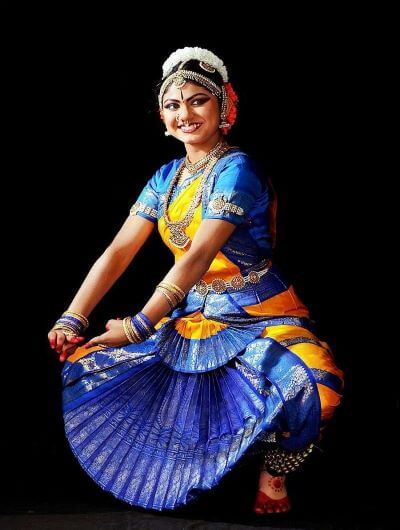
The word Bharatanatyam is made of different words with different meanings as described below:
Costumes in Bharatanatyam:The dancer of this dance form wears charismatic makeup, attractive costume (bright coloured sari) and shining ornaments. Music and Instruments in Bharatanatyam:South India's Carnatic style of music is used. The instruments used include Mridangam (double-sided drum), Nadaswaram (double-reed wind instrument), Surpeti, Venu, Kanjira, Manjira, Nattuvangam (cymbals), etc. Famous Bharatanatyam dancers:
2. KathakaliKathakali is originated in the southern part of the country in Kerala, India. This dance form represents storytelling; kathakali means storyteller in the native language. It is a religious classical dance form that originates from the tales of Shiva and Ramayana. The conversation related to storytelling of Hindu mythology takes place between dancers through their facial expressions and body gestures. 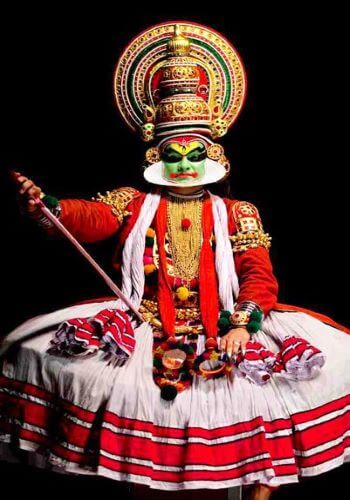
Kathakali represents the ancient heritage of India that is preserved for centuries in the Kathakali plays. It is mostly performed by men. To portray female characters the men wear the women' costumes. Traditionally, Kathakali is performed at night and continues until early morning. A kathakali dancer needs to have full concentration, skills, and stamina to perform this dance form. Costumes in Kathakali:There can be different types of costumes in this dance form depending on the character the dancer is playing. For example, Sathwika is worn by the hero, Minukku by the females, and Kathi is for the villain, etc. So, a character can be recognized easily by its costume and makeup. The characteristic features of this dance form include intriguing face movements and heavy costumes, traditional face masks, and the body of the dancer is painted with colours. For white colour, rice flour is used and for red Vermilion is used. The black colour is made from soot. Each colour has a meaning, for example, the red colour on the feet symbolizes evil character or intent. The green is used to represent noble characters, black is used for hunter and monsters, and yellow to show female characters. Music and Instruments used in Kathakali:The music used in Kathakali is similar to some extent to South Indian classical music (Carnatic sangeet). However, the instruments are not the same. The musical instruments used in Kathakali include Chenda (cylindrical drum), Shuddha Madalam (horizontally held drum), Idakka, Manjira. The main themes used in Kathakali include Mahabharat, Ramayan, Bhagvat Purana, and more. Famous Kathakali Artists:
3. KuchipudiThis classical dance form originated in Krishna district of Andhra Pradesh. Its name is derived from the village Kuchelapuram and it looks similar to Bharatanatyam. 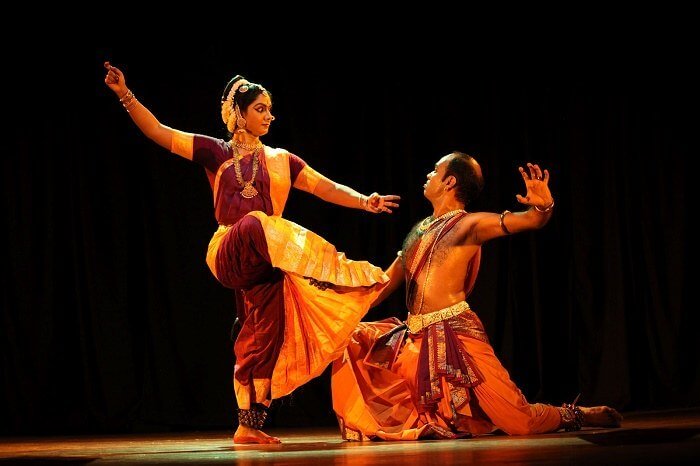
The themes of Kuchipudi is inspired by Lord Krishna, Rukmini, Satyabhama, etc. It is not only a dance, but also a sacred procedure as it includes burning of incense sticks, sprinkling holy water, and offering prayers to God. The characteristic feature of Kuchipudi is Tarangam in which the dancer performs on a brass plate and a pot on his or her head. The dancer is also required to sing along body movements, so this dance form requires a bit more skills and dedication. Costumes in Kuchipudi:Both male and female can perform this dance form. The female dancers wear a colourful sari, while the male ones wear dhoti. The dancers wear light makeup with traditional jewellery, ghunghru, and metallic waist belt. Music and Instruments used in Kuchipudi:The instruments used in Kuchipudi involves veena, flute, tambura, cymbals, and mridangam. Famous Kuchipudi Dancers:
4. KathakKathak is believed to be originated in North India where Kathakars (storytellers) used to travel to different places to communicate stories from ancient scriptures like Ramayan, Mahabharat and Lord Krishna stories through dance, music and songs. It got its name from the word "katha" which means "story" in English. It is known for its spins, outstanding rhythmic footwork, however, it also involves hand gestures, facial expressions and eye work. Both male and female dancer can be seen dancing together in this form of classical dance. 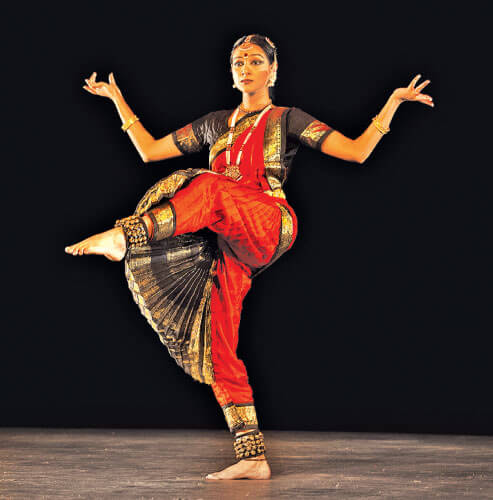
Costumes in Kathak:In Kathak, the dancer wears a sari with choli, or long embroidered skirt with choli with ornaments and ghunghru (musical anklet). The male dancers wear a combination of chudidar kurta and a dupatta tied at the waist. The dancers do not wear heavy makeup, it remains sharp and fine to show the expressions. A bun with a garland is also a part of the costume. The ghunghru are very heavy and used to produce a large variety of sounds to show heavy rains, the sound of horse riding, running train, etc. Music and Instruments in Kathak:Kathak can be performed with a large variety of music such as Bhajans, Slokas, Classical and light Classical Songs (Tumri, Kajri, Hori, Dadra), etc. Instruments are Esraj, Bansuri, Ghungharu, Harmonium, Santur, Pakhawaj, Sarod, Tabla, Sitar, Tanpura, etc. The famous schools or gharana of Kathak are:
Famous Kathak dancers:
5. MohiniattamIt is originated and evolved in the Kerala state of India. This classical dance form consists of soft, and gentle movements, so, it looks more graceful and feminine style of dancing. Its name is derived from the word "Mohini", which was a female avatar of Lord Vishnu. 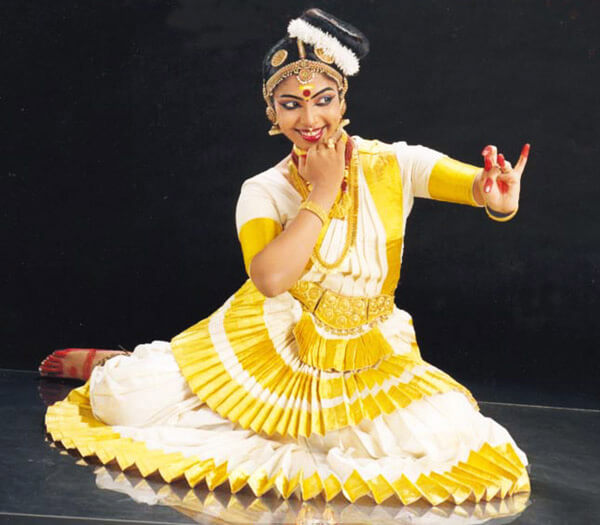
There are around forty movements in this dance form that are known as atavukal. It has grace and elegance like Bharatanatyam and vigour like Kathakali, apart from this, it is more erotic, delicate and lyrical. The moves include glides, up and down movement on toes and the focus remains on Mukhabhinaya or facial expressions. Costumes in Mohiniattam:The costume worn in Mohiniattam is a white plain sari embroidered with bright golden brocade in its borders accompanied with a matching choli (blouse). Besides this, a frilled cloth with concentric golden or saffron bands on the front part of the sari makes and a golden belt around the waist make the costume more attractive. The dancers wear light makeup, the fingers and feet are coloured with red natural dye to highlight the gestures. The dancers of Mohiniattam are easily identifiable by their bun or kuduma (one-sided hairstyle). Jewellery is worn on the head, around the neck, on hair and fingers. Ghunghru (musical anklets) are worn in the legs and are used to produce rhythmic sounds through the footwork. Besides this, Hindu tilak can be seen on the forehead, lips are coloured and eyes are lined to make the eye movements more visible. Music and Instruments:The vocal music used in this dance form is a mix of Malayalam and Sanskrit, while the style of music is Carnatic. The musical instruments used in Mohiniattam include Kuzhitalam (cymbals), veena, ldakka (hourglass-shaped drum), Mridangam (a barrel-shaped drum) with two heads, etc. Famous Mohiniattam dancers:
6. ManipuriManipuri is one of the main styles of Indian classical dances which is originated in the Manipur state of India and is also known as Jogai. Manipur is able to preserve its unique traditional cultures owing to its geographic location that keeps it protected from outside influences. 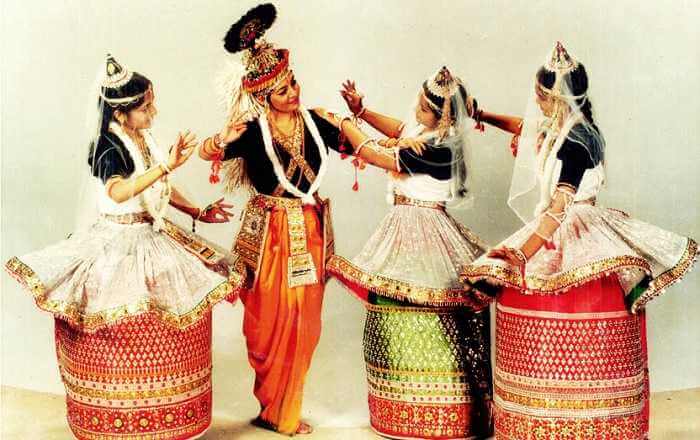
Manipuri dance is purely focused on religious aspects that are intended to give spiritual experience. It mainly narrates the love of Radha-Krishna and their romantic relationship, which is known as Raaslila. It emphasizes the movements of hands and upper body. The dancer wears a pleasing smile, shiny and decorative costume with ornaments, which makes this dance form very fascinating. The ghunghru which is the main feature of Indian classical dancers' costume is missing in the Manipuri dance. The themes in Manipuri dance mostly based on Hindu Vaishnavism and are also related to Shaivism, Shaktism and local goddesses. The tandav style theme represents the themes of Lord Shiva, Goddess Shakti and Lord Krishna as a warrior. The stories of Radha-Krishna is based on lasya theme. The raslila in Manipuri dance is performed in three different styles:
Costumes in Manipuri dance:The costumes are very unique as compared to the costumes in other dance forms. The male dancer wears a bright and colourful dhoti which is known as dhora or dhortra. It covers the lower body part from the waist. He also wears a crown decorated with the peacock feather. The costume of a female dancer looks similar to a Manipuri bride's costume. It is known as Potloi costumes. The most unique costume of a female dancer is Kumil, which is a decorated, barrel-shaped long skirt with a rigid bottom. It also has embroidery of gold and silver with small mirror pieces and border printed with lotus, rose or similar natural things. The top border of the skirt is fitted with a wavy skirt that is tied in three places around the waist and spreads out like a flower. A velvet choli (blouse) is worn on the upper part of the body, while a white, translucent veil or cloth is used to cover the head. Furthermore, jewellery and garlands are also worn to beautify face, neck, hand and waist. Unlike other classical dances, ghunghru is not worn by the dancers. Music and instruments used in Manipuri Dance:The poetry of Jayadev, Chandidas, Gyandas, and Govindadas is used for the expressions. It can be in Brij, Maithili, Sanskrit or other languages. The instruments played in Manipuri dance include Kartals, Jhanjh (Cymbals), Pung (Barrel Drum), Sembong, Harmonium, Pena (String instrument), Flute, Shankh (conch) and Esraj. Famous Manipuri Dancers:
7. OdissiOdissi is originated in the state of Odisha. It is a classical dance form that is lyrical, sensual as well as a dance of love and passion. It has found mention as Audramagdhi in the oldest Sanskrit Text, Natya Shastra. It is a mixture of Lasya and Tandav style. There are two traditional styles of Odissi that include Maharis (Temple girls or Devadasis) and Gotipua (it is performed by boys). In 2015, it was included in the syllabus of B.Tech in IIT Bhubaneshwar. It is believed to be the oldest dance form of India based on the archaeological evidence. 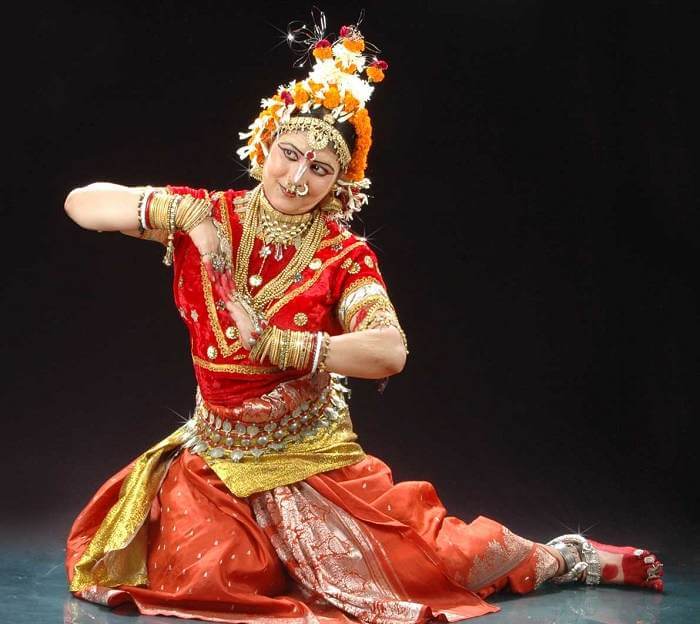
Odissi is based on Natya Shastra and the Abhinaya Darparna to some extent. The feelings are expressed through facial expressions, hand and eye movements and movements of other body parts. This dance form is intended to express the sacred tales of Hindu gods such as Surya and Shiva. So, it is accompanied by mythical stories and poems in Hindi. The two main body postures in this dance form include the Chowkand and Tribhanga. In Chowkand, the dancer position is like a square where the body is equally balanced on both the feet. In Tribhanga posture, the body of the dancer is deflected at the neck, torso, and knees. The upper body (torso) movement is a unique feature of Odissi dance form. Leg movements are numerous which are spiral or circular whether on the ground or above the ground. Besides these movements, there are also various gaits (movement of foot) for doing pirouettes (an act of spinning on one foot) and jumps and certain postures similar to sculptures that belong to ancient temples of India. Costumes in Odissi:The costume is made of traditional cloth. Men wear dhoti and women dancers wear a sari and a crown which is made in Jagannathpuri. White flowers can be seen attached to the bun. Silver coloured jewellery is worn, ghunghroos are also worn by the dancers. Music and Instruments used in Odissi:The south Indian and north Indian music is used in this dance form. The instruments include tabla, pakhavaj, harmonium, swarmandal, sitar, flute, violin, and cymbals. Famous Odissi Dancers:
8. SattriyaSattriya classical dance form originated in the 15th century A.D. It was introduced by the Mahapurusha Sankaradeva, a great Vaishnava saint of Assam, as a medium to spread the Vaishnava faith. It became popular as a part of the Vaishnav Bhakti Movement in Sattra (Hindu monasteries). 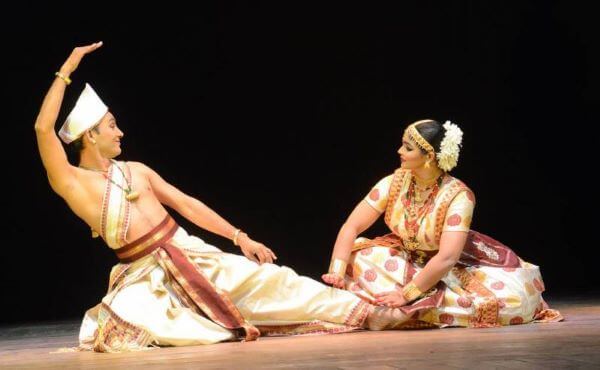
Over the years, it evolved and developed into a distinctive dance form. In 2000, it was recognized as one of the classical dances of India by Sangeet Natak Akademi. Both male and female dancers can perform Odissi. The themes in Sattriya are mostly based on Radha-Krishna stories, Dramas written by Sankardev, and other myths. There are two styles in this dance form; Masculine (Paurashik Bhangi), which is energetic and involves jumps, and Feminine (Stri Bhangi or Lasya), which is gentle and graceful. Costumes used in Sattriya:The male dancer wears a dhoti, chadar, and pagri (turban). The female dancer wears white flowers, chadar, ghuri, kanchi (waist cloth). The costumes related to characters and play can be worn. For example, masks are worn for special characters like demons. The traditional Assamese jewellery adorns the costumes of females and makes the dance moves more attractive and mesmerizing. Music and Instruments used in Sattriya:The music is Borgeet (a collection of lyrical songs) of Sankardev and Madhavdev, based on classical raga. The instruments include Khol (asymmetrical drum), Cymbals, manjira, flute, violin, harmonium, etc. Famous Sattriya Dancers:
Next TopicHighest Himalaya Mountain Peaks in India
|
 For Videos Join Our Youtube Channel: Join Now
For Videos Join Our Youtube Channel: Join Now
Feedback
- Send your Feedback to [email protected]
Help Others, Please Share









